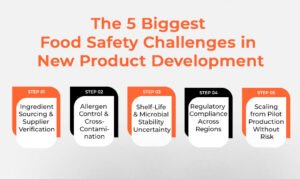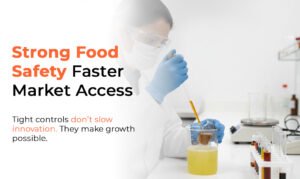Why Food Safety Is the #1 Barrier for Emerging Brands
Typically, food safety challenges are the first to come up when you are creating a new food product. Retailers ask for proof that you can handle the risk, regulators require complete documentation, and if there is even one mistake in your process, your launch can be delayed. In fact, what this implies is that many early mistakes in formulation or process flow can turn into new product development mistakes, which are expensive to rectify later on.
New brands, as a result, are more heavily burdened with this pressure than established manufacturers since they do not have proven systems. The positive side of the story is that these problems can be handled. You can deal with them without a change in your pace of innovation if you have the proper setup. An internal guide, Guide to Food Safety Compliance for Small Food Businesses, is available if you need more extensive support.
The 5 Biggest Food Safety Challenges in New Product Development
1. Ingredient Sourcing & Supplier Verification
At first, sourcing appears to be quite straightforward, but it becomes complicated when you have to validate every supplier. Safety issues of suppliers are the most common things that the first teams disregard in the assumption that the safety of suppliers is ensured. Especially when the ingredients come from brokers or different regions. With solid confirmation, you get the ability to trace the origin, but it cannot be done through vendor questionnaires only. You have to be provided with trustworthy COAs, have proper documentation of process controls, and be ready with the secondary supplier’s plan in case there is a change in the global supply. Achieving this correctly is a way of preventing from letting the sources of hazards from entering your plant before they escalate.
Need help building supplier approval criteria? Get the Supplier Verification Starter Template with Foodsure today.
🚀 Ready to get best Food Safety Solutions?
Get expert help with Food Innovation, compliance, and market-ready strategies. Book a FREE 30-minute consultation with our team today.
2. Allergen Control & Cross-Contamination
Allergen-related errors have been identified as one of the major causes of product recalls. Various formulas are tested, and small batches are run by different departments while a new product is being developed; hence, the risk of cross-contact is high. The point is that allergen mapping is your prerequisite for scaling and not your follow-up to your first production run. It covers not only the movement of people and tools but also cleaning cycles and correct label declarations.
3. Shelf-Life & Microbial Stability Uncertainty
Almost all brands shelve life as a guess during the development stage and have a plan to define it more precisely later on. However, that guess can end up costing you. Real shelf life work involves microbial challenge studies, pH and water activity tests, and knowing very well how your product behaves when it is exposed to a temperature that is not suitable. If you do not confirm it in the early stage, you might find that your product will spoil after the retailer has reviewed it, which is the worst time to fix it. Reliable data is what makes you safe and, at the same time be able you to sell your product in the market.
4. Regulatory Compliance Across Regions
In the case where you intend to sell beyond the state or country limits, your process must conform to FSMA standards, your paperwork shows that you have applied the HACCP system, and your labels are in accordance with the local requirements. Observance of the law varies from one place to another; thus, the assumptions put forward during the preparation may result in a delay of your work. Regularity and neatness are the factors that enable your product to advance to distribution.
5. Scaling from Pilot to Production Without Risk
Scaling is the stage at which even the most carefully designed products can abruptly be confronted with new dangers. Differences in equipment, increased line speeds, changes in ingredients, and errors made by humans can all result in a change in your risk profile. Having a controlled scale-up strategy ensures that you are not taken by surprise and also provides manufacturers with trust in your process.
Trends in Food Product Development
How to Solve Food Safety Challenges Before Launch
Build a Safety-First NPD Workflow
A clean workflow removes guesswork. At a minimum, include:
- A documented hazard review at the concept stage
- Supplier verification before pilot batching
- Allergen and label checks tied to each formula revision
- pH, water activity, and preliminary microbial testing while still in R&D
- A formal review of all food safety challenges before any production trial
- A single person is accountable for the sign-off
This keeps your development work anchored in real safety expectations, not assumptions.
Run Preventive Testing Early
Early testing protects you from redesigns that chew up time and money. Conduct your pH and water activity studies, challenge tests, and preliminary shelf-life checks as soon as your formula is stable. You’ll catch risks long before they hit the pilot line.
Use Expert Validation Before Retail Submission
Retailers want more than an idea. They want proof that your process is safe and repeatable. A pre-submission review from a qualified expert gives you a clean HACCP plan, validated controls, and a package you can hand to any buyer with confidence. This is often the difference between a quick yes and a long delay.
When to Bring in a Food Safety Consultant
Bring in a food safety consultant when your team lacks time, regulatory experience, or the capacity to manage complex safety questions across suppliers and production partners. A specialist can close knowledge gaps, validate your controls, and help you avoid hidden food safety challenge variations that stall launches. The right food expert protects your brand and accelerates your path to retail.
Conclusion: Strong Food Safety = Faster Market Access
Tight controls don’t slow innovation. They make growth possible. If you incorporate safety in your development from the very first day, retailers will have faith in you, regulators will be relaxed, and your launch will be quicker. Are you ready to move forward? Let us fortify your method. Contact Foodsure at +91 8130404757 to access all the information and services you need to make your brand the one choice for India and International.
Also Read: Food Packaging and Labeling Regulations

🚀 Free Food Safety Consultation
Trusted by 500+ D2C Brands
Frequently Asked Questions
What is a challenge to food safety?
One of the major factors that can cause food safety to be seriously challenged is contamination of food by bacteria, chemicals, or improper handling.
What are the 5 most common risk factors for food safety?
The major causes of food safety risk factors include bad hygiene, undercooking, unsafe storage, use of contaminated raw materials, and cross-contamination.
What are the problems with food safety?
Among the most frequently occurring problems related to food safety are foodborne illnesses, spoilage, chemical contamination, and lack of regulation.
What are the challenges of food safety in developing countries?
The major factors that contribute to difficulties in food safety in developing countries are limited infrastructure, poor hygiene, lack of training, and weak regulations.
What are the 10 mistakes of food safety?
Some of the most common mistakes that lead to food safety issues include not washing hands, undercooking food, cross-contamination, improper storage, using expired ingredients, ignoring temperature control, using dirty equipment, using unsafe water, poor cleaning, and ignoring pests.
What are the three biggest challenges of the food system?
The three major issues of the food system are food waste, unequal access, and production practices that are either unsafe or unsustainable.
What are the major challenges?
Providing food for an ever-growing population, making sure that the food is nutritious, and ensuring that the food is both safe and environmentally friendly.
What is the 30 Foods Challenge?
Consuming 30 different foods in 30 days to broaden one’s palette and nutrition.
What are food challenges?
Are they enjoyable or daring eating activities that put to the test the taste, quantity, or spiciness of the food?
